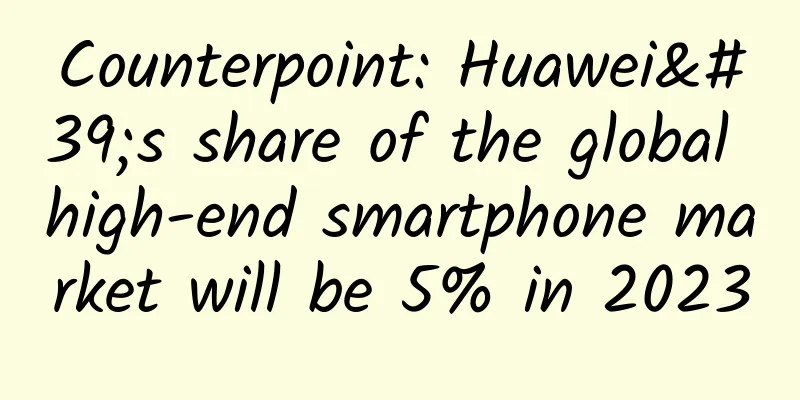Counterpoint: Huawei's share of the global high-end smartphone market will be 5% in 2023

|
Although global smartphone sales declined in 2023, sales of high-end smartphones still maintained a 6% growth. With the return of Kirin, Huawei has won 5% of the global high-end smartphone market in 2023 with the hot sales of the Mate 60 series and Mate X5 series. It should be noted that in 2019, Huawei's share of the high-end smartphone market was as high as 16%. The latest rumors show that Huawei has recently placed "additional orders" to the supply chain, with the goal of shipping 7 million to 10 million foldable screen phones in 2024, which will be a maximum increase of about 3 times compared to 2.3 million units in 2023. If this goal can be achieved, it will help Huawei further increase its share in the high-end smartphone market. Apple monopolizes 71% of the global high-end smartphone market, and Huawei's share has recovered to 5%! According to a survey report by market research firm Counterpoint Research, global sales of high-end smartphones (priced above US$600) are expected to increase by 6% year-on-year in 2023, setting a new record high. This is in stark contrast to the entire smartphone market, which is likely to see sales shrink in 2023, with the Indian market already the fastest growing high-end smartphone market in the world. In terms of revenue share, sales of high-end smartphones in the global smartphone market in 2023 will reach a record high of 24%, three times that of 2016. From the overall trend, we can see that the sales share of high-end smartphones has been growing since 2016, and only in 2020 it remained the same as in 2019 and did not grow. Judging from the performance of specific manufacturers, in the high-end smartphone market in 2023, Apple iPhone continued to dominate the high-end smartphone market with a market share of up to 71% , but it fell by 4 percentage points compared to 2022. Samsung, ranked second, took a 17% market share thanks to the sales of Galaxy S23 and foldable smartphones. Although this is less than a quarter of Apple's, it has increased by 1 percentage point compared to 2022. Ranked third is Huawei. Thanks to the hot sales of the Mate 60 series and Mate X5 series, Huawei's share of the high-end smartphone market increased from 3% in 2022 to 5%, an increase of two percentage points. However, in the first quarter of 2019 when Huawei was not restricted, its market share in the high-end smartphone market was as high as 16%. After Huawei was suppressed by the United States, Apple took over most of the high-end smartphone market vacated by Huawei. Counterpoint also further pointed out in its latest report that Apple's shrinking market share in the high-end smartphone market in 2023 will be mainly due to the return of Huawei's Mate 60 series models to the Chinese market. Data previously released by Counterpoint Research showed that Huawei's Mate60 series had domestic sales of 2.4 million units in the eighth week of its launch. Canalys data also shows that as of November 7, the total sales of Huawei's Mate60 series have risen to 2.5 million units. Xiaomi ranked fourth with a market share of 2%, an increase of 1 percentage point compared to 2022. This is mainly due to the hot sales of the Xiaomi 14 series. On the morning of November 7, Lei Jun, founder, chairman and CEO of Xiaomi Group, responded to netizens' comments on Weibo, saying: " The sales volume of Xiaomi 14 has exceeded 1 million units , but there is still a serious shortage of stock. We are desperately urging orders. Please be patient and wait." OPPO ranked fifth, with a market share of 1%, the same as in 2022, thanks to the sales of the Find X series and Find N series. It is rumored that Huawei's foldable screen shipment target this year has reached 10 million units, and it is stocking up on key components such as CIS! In the high-end smartphone market, the sales volume and sales share of foldable phones continue to increase. Counterpoint data shows that consumers purchased about 16 million foldable phones in 2023. It is expected that in 2027, ultra-premium phones (including foldable phones and traditionally designed phones) will currently account for 33% of high-end smartphone sales. Since these phones typically fall into the so-called ultra-premium category, meaning phones priced at $1,000 or more, their share in terms of sales will be even higher. To this end, Huawei, which has returned to the high-end smartphone market with the Kirin chip, will also focus on the foldable screen market in the future. According to Taiwanese media reports, Huawei has not only not cut orders for foldable screens recently, but has also placed "additional orders" to the supply chain, with the goal of shipping 7 million to 10 million foldable screen phones in 2024, which will be a maximum increase of about 3 times compared to 2.3 million units in 2023. The relevant supply chain manufacturers declined to comment on the rumor. However, regarding the rumor that Huawei "cancelled orders", some suppliers said that this was not the case. Zhaoli, the main supplier of Huawei's folding screen hinges, emphasized that the company had not been cut by major customers, and the shipment of its folding machine-related bearing products was smooth and operations were quite normal. It is reported that in order to achieve this goal, Huawei has begun to aggressively purchase key components, CMOS image sensors (CIS). This is mainly because, after several quarters of continuous downturn, mobile phone CIS has begun to bottom out and rebound as the smartphone market recovers, causing CIS prices to start rising. Previous news showed that Samsung, a major CIS manufacturer, would increase prices by 25% to 30% in the first quarter, which may also drive other CIS manufacturers to follow suit. In order to avoid higher prices in the future, CIS naturally became a key component that Huawei stocked in advance. According to market rumors, the CIS for Huawei's foldable phones is mainly supplied by OmniVision, a major domestic CIS manufacturer. The relevant inventory has increased several times as the shipment target of the whole machine has increased significantly, which has also brought about huge demand for CIS back-end packaging and testing. Taiwanese media reported that OmniVision Technologies' CIS back-end packaging and testing is mainly undertaken by Tongxin Electronics, a subsidiary of Yageo Group, and Precision Materials Technology, which is invested by TSMC. Tongxin Electronics said at a recent earnings conference that it had observed that the four major production lines had all shown quarterly growth in the fourth quarter of last year, especially the smartphone CIS, driven by the demand for inventory replenishment, and prices began to move towards normal levels. With the recovery of mobile phone demand and the automotive CIS emerging from the shadow of inventory adjustment, Tongxin Electronics' performance this year will return to the growth track, and the annual profit growth may exceed 40% year-on-year. Jingcai Technology is also a packaging and testing supply chain manufacturer related to OmniVision Technologies, mainly providing wafer-level packaging, and mainly focusing on mobile phone applications. With the recovery of demand in terminal markets such as smartphones, Jingcai Technology's 12-inch Cu-TSV (copper wire) process and MEMS micro-electromechanical new businesses have been gradually accepted or shipped in small quantities, and their contribution in 2024 will be further amplified. In addition to CIS, memory chips have also started to rebound since the fourth quarter of last year, and have been "rising continuously" recently, and are expected to be the focus of Huawei's stocking. In addition, the production capacity of Kirin chips is also the key bottleneck for Huawei's continued expansion of high-end model shipments. According to statistics from market research firm Gartner, in the first half of last year, Samsung had a market share of 71% in the foldable phone market, Huawei ranked second with 12%, and the rest of the market was mainly divided among Chinese brands such as OPPO, Honor, and vivo. It is reported that Huawei will launch three foldable phones this year and continue to expand its overseas markets. It is expected to continue to narrow the gap with Samsung in the foldable screen market and further increase its share in the high-end smartphone market. Zikuai Technology |
>>: Zoom financial report: Zoom revenue increased 12% to US$1.07 billion in Q1 2022
Recommend
What to do if there is a peculiar smell after sex
In general married life, it is necessary to pay a...
What are the hazards of yellow and black vaginal discharge
After women enter puberty, they will have new leu...
A man at forty! Many parts of the body are malfunctioning
There is a Chinese saying: "A woman at forty...
What is ovarian adenoma?
Ovarian cystadenoma is a manifestation of ovarian...
The withdrawal bleeding stopped in one day.
The duration of withdrawal bleeding will also var...
What should I do if I want a third child but encounter ED?
《Cotton Swab Medical Science Popularization》 Chen...
What causes nipple pain before menstruation?
There are many issues that women need to pay atte...
Diagnosis and treatment of pregnancy induced hypertension
Giving birth to a child is the most painful thing...
What to do if you have stomach pain during pregnancy
If a woman develops some physical conditions duri...
“Health from eating” series | National Nutrition Week: Sterilized eggs are not sterile, do you still dare to eat them “raw”?
As the main consumer groups in society change, yo...
Sensor Tower: US Retail Application Report 2023
Sensor Tower released its "U.S. Retail Apps ...
Can I eat salted duck eggs during menstruation?
Women should pay attention to their diet during m...
Pregnant woman 36 weeks of bleeding
Pregnant women will have spotting when they reach...
How much money do you need to prepare to have a child?
With prices rising day by day and it being diffic...
Why do my breasts hurt after every feeding?
Mothers often encounter some minor problems when ...









